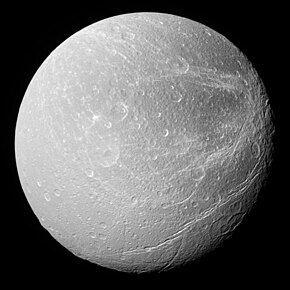
Back Dione (maan) AF Dione (Mond) ALS Dione (satelite) AN ديون (قمر) Arabic Diona (Saturnun peyki) AZ دیونه (قمر) AZB Дыёна (спадарожнік Сатурна) BE Диона (спътник) Bulgarian Dione (satèl·lit) Catalan Dione (ôi-sĭng) CDO
 Dione photographed in natural light by the Cassini spacecraft in 2008 | |
| Discovery | |
|---|---|
| Discovered by | Giovanni Cassini |
| Discovery date | 30 March 1684 |
| Designations | |
Designation | Saturn IV |
| Pronunciation | /daɪˈoʊniː/[1] |
Named after | Διώνη Diōnē |
| Adjectives | Dionean[2] /daɪəˈniːən/[3] |
| Orbital characteristics | |
| 377396 km | |
| Eccentricity | 0.0022[4] |
| 2.736915 d[4] | |
| Inclination | 0.019° (to Saturn's equator) |
| Satellite of | Saturn |
| Physical characteristics | |
| Dimensions | 1128.8 × 1122.6 × 1119.2 km[5] |
| 561.4±0.4 km[5][6] | |
| 3964776.51 km2[7] | |
| Mass | (1.0954868±0.0000246)×1021 kg[6] (1.834×10−4 Earths) |
Mean density | 1.4781±0.0032 g/cm3[6] |
| 0.212 m/s2 | |
| 0.51 km/s | |
| 2.736915 d (synchronous) | |
| zero | |
| Albedo | 0.998±0.004 (geometric)[8] |
| Temperature | 87 K (−186°C) |
| 10.4 [9] | |
Dione (/daɪˈoʊni/), also designated Saturn IV, is the fourth-largest moon of Saturn. With a mean diameter of 1,123 km and a density of about 1.48 g/cm3, Dione is composed of an icy mantle and crust overlying a silicate rocky core, with rock and water ice roughly equal in mass. Its trailing hemisphere is marked by large cliffs and scarps called chasmata; the trailing hemisphere is also significantly darker compared to the leading hemisphere.
The moon was discovered by Italian astronomer Giovanni Domenico Cassini in 1684 and is named after the Titaness Dione in Greek mythology. Dione was first imaged up-close by the Voyager 1 space probe in 1980. Later, the Cassini spacecraft made multiple flybys of Dione throughout the 2000s and 2010s as part of its campaign to explore the Saturn system.
- ^ "Dione". Lexico UK English Dictionary. Oxford University Press. Archived from the original on 22 March 2020.
"Dione". Merriam-Webster.com Dictionary. Merriam-Webster. - ^ JPL (13 March 2007) Cassini: Dionean Linea Archived 26 October 2021 at the Wayback Machine
- ^ Len Krisak (2011) Virgil's Eclogues, p. 71
- ^ a b "Data for our solar system". Exp.arc.nasa.gov. 20 April 2003. Archived from the original on 9 March 2005. Retrieved 21 May 2007.
- ^ a b Cite error: The named reference
Roatsch2009was invoked but never defined (see the help page). - ^ a b c Jacobson, Robert. A. (1 November 2022). "The Orbits of the Main Saturnian Satellites, the Saturnian System Gravity Field, and the Orientation of Saturn's Pole*". The Astronomical Journal. 164 (5): 199. Bibcode:2022AJ....164..199J. doi:10.3847/1538-3881/ac90c9. S2CID 252992162.
- ^ Cite error: The named reference
Solar System Explorationwas invoked but never defined (see the help page). - ^ Cite error: The named reference
Verbiscer et al. 2007was invoked but never defined (see the help page). - ^ Cite error: The named reference
Observatorio ARVALwas invoked but never defined (see the help page).